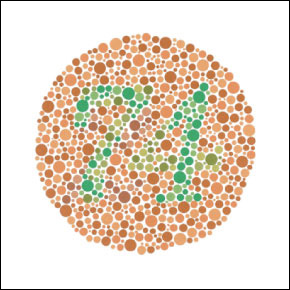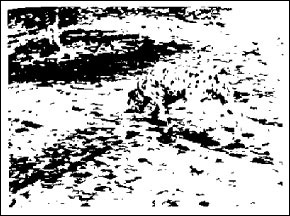
« Previous
Session Overview
How do sensation, perception, and expectation create what we see? This discussion session complements the prior lecture sessions Vision 1 and Vision 2.
Discussion
…We'll talk about perception – how the brain interprets the information that's out there and how it realizes the content of the world based on bottom-up processes. We'll talk about expectation – how the things that you know about the world bias your interpretation of what's going on; how stuff that we know is true, based on our long-term experience, changes what we perceive, even with the same physical evidence.
Experiment
Retinotopy in Visual Cortex
The referenced experiment is described in Tootell, R.B., et. al. "Deoxyglucose Analysis of Retinotopic Organization in Primate Striate Cortex." Science 218 no. 4575 (1982): pp. 902-904.
Cells in visual cortex each get information from a particular part of the world. This region is called the cell's visual field. The cell responds to anything that enters its field. Based on the ensemble response of neurons in visual cortex, the brain can figure out the big picture.
In this experiment, researchers showed a pattern of circles and spokes to a monkey. The tiny squares flashed black and white, which really excited the cells in visual cortex. They also injected radioactively-labeled deoxyglucose, which was taken up by active cells. In a slice of visual cortex, the neurons that were firing are stained dark. If possible look at the picture in the article. What do you notice about this map of visual cortex in relation to the picture? In what ways are they similar, and in what ways are they different?
› Sample Answer
There is a clear correspondence in the pattern of rings and the lines connecting them. However, it’s not to scale. There’s lots of visual cortex devoted to representing what’s at the center, at the fovea. Much less of the cortex, proportionally, is devoted to representing what’s on the periphery.
Given what we know about how well we perceive things at the center of our field of vision versus on the periphery, does this make sense? Why do you suppose we evolved this way?
Demonstrations
Color Vision
Please load this link. Stare at the black dot. Please try not to blink.
The Big Spanish Castle
Why did you see the black and white image of the castle in color? According to the Opponent Process Theory of Color Vision, for some pairs of colors (red and green, blue and yellow), the presence of one inhibits us from seeing the other in the same location on the retina. When you're staring at the opposing colors in the first image, your photoreceptors begin to adapt to the stimulus. Once you shift to a neutral, grayscale picture, the opponent colors begin to fire, as they are no longer being inhibited.
Color Blindness
The most common type of color blindness is the inability to distinguish red and green. Can you read the number within the circle?

Ishihara Plate 9
Depth and Size Cues
What is happening with this giant child and her tiny father?

Photo courtesy of Keith Uden on Flickr.
This scene was designed to trick your eyes into seeing the adult (who is in the distance) as smaller than the kid. Our brain knows certain things about the world: That squares are square, and that floors and ceilings are parallel. These are facts about the world that allow us to interpret what we see. However, everything in this room is slanted. This illusion is interesting because the size information given by the depth cues (texture and perspective) contradict what we know about the actual size of people.
Expectations Changing Perception
What do you see in the image below?

Courtesy of Elsevier, Inc., http://www.sciencedirect.com. Used with permission. R.C. James, as seen in Tai Sing Lee (2003). Computations in the early visual cortex. Journal of Physiology 97, 121-139. Retrieved from ( PDF - 1.2MB)
PDF - 1.2MB)
Do you see it?
It's a Dalmatian sniffing the ground under a tree.
Do you see it now?
The truth is, once you know that there's a dog, you will always and forever see the dog in this picture. Why? Well, in addition to all of the feedforward systems in the brain (world → retina → lateral geniculate nucleus (in the thalamus) → V1 (visual cortex) → V2, V4, MT areas), there is also a feedback system. In fact, there are about 10 times as many feedback connections as feedforward connections in the visual system. The brain does not passively absorb visual information, it uses memory to impose its interpretations on the visual world.

Image by MIT OpenCourseWare.
Configural versus Holistic Viewing
Who are these people?


Reprinted by permission from Macmillan Publishers Ltd: Nature. Source: Sinha, Pawan, and Tomaso Poggio. "I Think I Know That Face..." Nature 384 (1996): 404. © 1996.
Al Gore and Bill Clinton, of course. Dick Cheney and George Bush, of course.
Really?
Take a look at Gore's eyes and Clinton's eyes. Cheney's eyes and Bush's eyes. Gore's mouth and Clinton's mouth. Cheney's mouth, and Bush's mouth.
What's going on?
In each case, the president's face has been copied onto the vice president's head.
We don't see faces in parts, we see them in wholes – this is holistic processing. The illusion works because we expect the guy standing behind Clinton to be Gore, and because cues such as hair and glasses override our processing of the features.
« Previous
